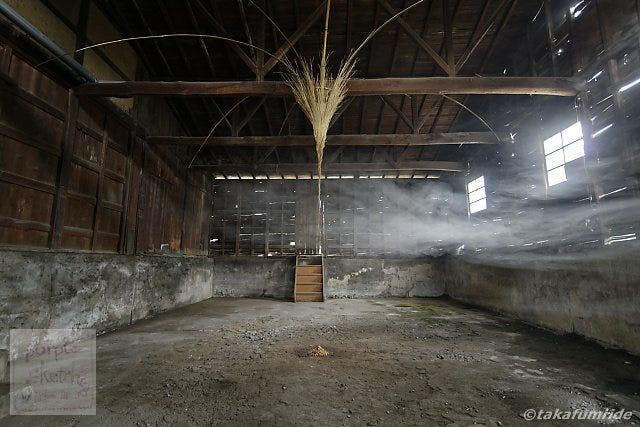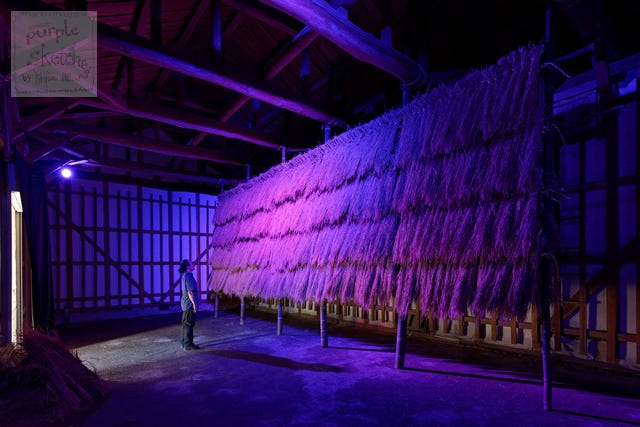Lately, I've found myself talking almost exclusively about the guitar. It's easy to just talk about things, but actually continuing to take action is much harder. Over the past three months, I feel like I've improved quite a bit, but I wonder how it looks from an outsider’s perspective. I'm thinking of sharing my progress by recording a video — a style that's been trending here on Substack lately. Stay tuned!
(Two days after writing this, I threw out my back while working in the garden. It's been a week and it still hurts.😞)
ここ最近、すっかりギターの話ばかりになってしまいました。話すだけなら誰にでもできるけれど、継続して実行するのはなかなか難しいものです。この3ヶ月で、自分の中ではかなりギターが上達した実感がありますが、他人から見たらどうでしょうか。その進歩を、最近このSubstackでも流行ってきた「ビデオを撮って報告する」スタイルで紹介しようかな、と考えています。お楽しみに。
(……と書いた2日後、庭作業中にギックリ腰をやってしまいました。一週間たってもまだ痛い😞)
Now, in this issue, I’m excited to finally share some updates on my visual art activities. The original reason I started this Substack last year was to follow up on my "イワノワヘ circulate" Peace Card Project at the Nakanojo Biennale 2023, and to share various creative processes with all of you.
さて、本号では、久しぶりにヴィジュアルアートに関するご報告です。そもそも私が昨年Substackを始めたきっかけは、中之条ビエンナーレ2023において「イワノワヘcirculate」のピースカードプロジェクトのフォローアップを兼ねて、皆さんに制作プロセスなどをご紹介したいと思ったからでした。
I had hoped to send a Peace Card to everyone who requested one, but unfortunately, I lost contact with many people along the way, and the project didn’t progress as smoothly as I had envisioned. Still, it brings me great joy that I was able to deliver cards to those of you who have been reading this newsletter since the beginning.
ピースカードも、希望してくださった全員にお渡ししたかったのですが、連絡が取れなくなってしまった方も多く、プロジェクトはなかなか思うように進みません。それでも、初回からこのニュースレターを読んでくださっている方にカードを届けられたことは、本当に嬉しく思っています。
That said, two years have flown by before I could even properly mint the Peace Cards. Recently, services that handle both cryptocurrency and cash transactions have finally started to emerge, so I’m currently waiting for the platform I’m involved with to catch up.
とはいえ、ピースカードのミント(発行)もままならないうちに、あっという間に2年が経ってしまいました。最近ようやく、暗号通貨と現金の両方に対応してくれるサービスが少しずつ出てきたので、今は私が関わっているプラットフォームが対応してくれるのを待っているところです。
And now, Nakanojo Biennale 2025!
The official announcement was finally made in April, and I’m happy to share here that I will be participating as well 🤗
In this issue, I’d like to start documenting the process leading up to the event.
そして、中之条ビエンナーレ2025!
4月に入ってようやく正式発表となり、この場を借りて、私も参加することをお知らせできる運びとなりました🤗
そこで今回は、そのプロセスについて少しずつ記していこうと思います。
The Nakanojo Biennale is held once every two years, with applications opening around the summer, roughly a year before the event. Some artists from overseas are invited as part of cultural exchange programs, but in my case, I have been participating through the general international open call since 2017. As such, I have been fully self-funded up to this point.
Starting with this edition, however, artists who are accepted will receive an artist fee of 100,000 yen (April 28, 2025 $1=¥143 approximately $700) from Nakanojo Town, which is double the amount compared to previous years. From an artist’s perspective, this is a very welcome change.
中之条ビエンナーレは2年に一度開催されており、そのアプリケーション(応募)は、開催の約1年前、夏頃に募集があります。海外から参加する作家の中には、文化交流招聘作家として招かれる方もいらっしゃいますが、私の場合は海外一般公募枠として、2017年から参加させていただいています。そのため、これまで資金はすべて自分で用意してきました。
今回からは、参加が認められた作家に対して中之条町からアーティストフィーとして10万円が支給されることになり、以前に比べると2倍の支援となりました。作家側の立場としては、これはとても嬉しい変化です。
Artists wishing to participate for the first time are required to visit the exhibition sites in person before applying. Attending this orientation and physically visiting the potential venues holds great significance. Since I have participated four times in the past, I was allowed to attend the orientation online this time. After familiarizing themselves with the venues, artists who wish to apply must submit their preferred exhibition sites along with around three project proposals. The executive committee then reviews the submitted ideas and the artists’ backgrounds to select the participants.
初めて参加を希望する作家は、申込み前に必ず会場の下見を行わなければなりません。このオリエンテーションに参加し、実際に展示できる場所を訪れることには、大きな意味があります。私はこれまでに4回参加させていただいているため、今回はオンラインでのオリエンテーションのみとさせていただきました。会場を把握したうえで参加を希望する作家は、展示を希望する会場とプロジェクト案を3つほど提出します。提出されたアイデアや作家の経歴をもとに、実行委員会が参加作家を選出するという流れになります。
I’ve heard that the Nakanojo Biennale originally began as a venue for young artists who had moved to Nakanojo to present their own works. In recent years, a theme has been assigned for each edition, but fundamentally, adhering strictly to the theme is not required — and I feel this flexibility is one of the unique characteristics of the Nakanojo Biennale. In my case, I participate by aligning with the theme while also setting personal challenges for myself, approaching each project with the determination to accomplish them.
中之条ビエンナーレの成り立ちは、中之条に移り住んだ若手作家が、自らの作品を発表する場として始まったと聞いています。近年の開催ではテーマが設けられていますが、もともとはテーマに沿う必要はなく、それがある意味、中之条ビエンナーレの特徴でもあると感じています。そのため私の場合、テーマに寄り添いつつも、自分自身への課題を設定して参加し、それを達成する思いで毎回取り組ませていただいています。
My proposal this time was quite unclear. The one thing that was clear in my mind was the desire to "try exhibiting outdoors." Looking back, I realize that preparing for an outdoor exhibition in the scorching heat of midsummer might be a bit risky, especially since I’ve had heatstroke on-site in the past. But still, I’m determined to take precautions and give it my best. When writing a proposal, I tend to forget that the production period falls in the middle of summer.
今回の私のプロポーザルは、とても不明瞭なものでした。唯一、私の中でハッキリしていたのは「屋外で展示をしてみたい」ということでした。今思うと、真夏の酷暑の中で屋外展示の準備をするのは、過去に現場で熱中症になった経験があるので、少し危険かなとも思いますが、それでも注意しながら頑張ろうと考えています。プロポーザルを書く時、真夏の制作期間ということをつい忘れがちなんですよね。
In my first participation in 2017, I returned to Japan three times in total: for the site visit, the production period, and the exhibition dismantling after it ended. The most important thing for me when participating in an exhibition from a remote location is ensuring that the works are made in a way that minimizes the risk of damage during the exhibition. Over the past eight years, what I have cultivated as an "artist" in the Nakanojo Biennale is the trust that "Ide’s works require minimal maintenance and are easy to handle during the exhibition period."
初めて参加した2017年の展示では、下見、滞在制作期間、展示終了後の搬出と、合計3回日本に帰国して対応しました。私が遠隔地での展覧会に参加する上で最も大切にしていることは、展示開催中に作品が壊れないように作ることです。過去8年間で中之条ビエンナーレで私が「芸術家」として培ってきたものは、「井出の作品は展示期間中のメンテナンスが最小限で、扱いやすい」という信頼だと自負しています。
After exhibiting my 2017 work "トキハナツ liberate" and completing the piece "サマヨヲ hover" in 2019, I felt that I had nearly perfected the challenges surrounding the electronic components and their control. As a result, I felt the need to move on to the next step in my work. Both of these pieces also had a focus on the materials used. I sourced bamboo and straw, materials I had been familiar with since childhood, locally. Ultimately, I dismantled the materials on-site, selecting those that could, if possible, be reused or naturally returned to the environment.

2017年の作品「トキハナツ liberate」を展示し、2019年に作品「サマヨヲ hover」を完成させた後、自分の電子部品やその制御における課題はほぼ完璧にクリアしたと感じました。そのため、次のステップへ進む必要を感じ、活動を始めました。これらの2つの作品には、主に使用した材料にもこだわりがありました。私の子供の頃に慣れ親しんだ素材である竹や藁を現地で調達し、最終的には現地で解体し、可能であれば再利用または自然に戻る素材を選んでいました。

When I can handle both the installation and deinstallation myself, I am able to create works that are technically and structurally complex. However, after experiencing remote participation in the 2021 Nakanojo Biennale, following the COVID-19 lockdown, I began to wonder whether it might be possible to create works that don’t require me to control everything personally. Here (Photo below) is the AR (Augmented Reality) work I created at that time, titled "トオクチカク perceive."
作家として搬入と搬出を自分でこなせる場合、技術的にも仕組み的にも手の込んだ作品を作ることができますが、COVID-19のロックダウン経験を経て、2021年の中之条ビエンナーレでリモート参加を体験してからは、すべてを自分でコントロールする必要のない作品が作れないかという考えが生まれました。こちら(上写真)が、その時に制作したAR(拡張現実)を利用した作品「トオクチカク perceive」です。
With this stance, I aimed to create works that could be deinstalled by anyone, eliminating the need for me to return to Japan for the deinstallation. This was the concept behind my 2023 work "イワノワヘ circulate." By connecting its technical aspects to blockchain, I created a work that links not only to the present moment but also to a long, possibly eternal, passage of time. So far, this time seems to be moving slowly within me, but can you see it?
そのスタンスで、作品搬出は誰でもできるようにすることで、搬出のために再度来日する必要がない作品を作ろうと考えたのが、2023年の「イワノワヘ circulate」という作品でした。そして、その技術的な面をブロックチェーンに繋げることで、その場限りではなく、長い時間、さらには永遠とも言える時間に繋がる作品を制作しました。今のところ、その時間は私の中でゆっくり進んでいるのですが、皆さんには見えていますでしょうか?
For me, the process of creation is a large part of the work, so this topic definitely deserves a deeper dive. However, since I want to publish newsletters on time, I’ll keep it brief for now and save the detailed discussion for another time.
私にとって、このような制作のプロセスが作品の大部分を占めているので、この話はもっと深掘りしていく必要があるのですが、今月中にニュースレターを発行したいので、今回は少し省略して、またの機会にお話ししましょう。
Given all this, this will be my only trip back to Japan, both economically and socially. I plan to stay in Nakanojo from mid-July to early August to create and complete my work.
Now, as for what kind of work I will create… the truth is, I haven’t yet finalized the idea to its final stage. I’d love to share the process with you here, so I appreciate your support. If possible, I’d also like to hear your reactions, as such exchanges can be a very interesting part of the creative process.
まぁそんなことから、今回は経済的にも社会的にも日本への帰国は1度きり、7月半ばから8月頭の中之条町滞在中に制作し、そして完了させるつもりで予定しています。
さて、それではどんな作品を作るかと言うと…、実はまだ最終段階までアイディアが突き詰められていません。そのプロセスも含め、ここでプロセスをお伝えできればと思っていますので、よろしくお願いします。できれば皆さんの反応も伺ったり、そういったやりとりも作品制作のプロセスとしてとても面白いものではないでしょうか。
Let’s get back on track.
After the artists hoping to participate propose three ideas, they will receive a notification from the organizing committee about the venue allocation. When this notification arrives, the artist will know whether they have a chance to participate in the exhibition. After confirming that the assigned venue is appropriate, they submit an agreement, and at this point, their participation is 99% confirmed. Of course, it’s not 100% confirmed until the official announcement is made.
話を元に戻しましょう。
参加希望する作家は3つのアイディアを提案した後、実行委員会から会場の割り当てのお知らせが届きます。このお知らせが届いた時点で、作家は自分が展示会に参加できる可能性を知ることになります。割り当てられた会場が適切であるかどうかを確認し、その後同意書を提出すると、この時点で99%参加決定と言えるでしょう。もちろん、公式の発表があるまでは100%確定というわけではありませんが。
Among the ideas I submitted, I had three preferred locations for outdoor installations. However, I also mentioned that if the organizing committee recommended a location I was unfamiliar with, I would be open to creating work there. The location proposed by the committee turned out to be the old mountain behind the former Isama Elementary Middle School, which had not been used as an exhibition site since Mr. Yamashige, the director of the Nakanojo Biennale, exhibited there in 2007 - 2009. I’ve seen the place, but I’ve never actually climbed it, so for me, it’s an unknown location.
私が提出したアイディアの中で、屋外での設置希望場所は3つありましたが、その一方で、私の知らない場所で実行委員会側が薦める場所があれば、その場所で制作したいともお伝えしました。そして、実行委員会から提案された場所が何と、2007-2009年に中之条ビエンナーレのディレクターでもある山重さんが展示された後、誰も作品会場として利用していない旧伊参小中学校裏山でした。ここは見たことはありますが、実際に登ったことがないので、私にとっては未知の場所です。
Based on the materials I received, I can get a general idea of the place, but I still have some concerns and excitement about how the natural surroundings will change from now through summer and into autumn. Nevertheless, it seemed like a very enjoyable location, so I agreed to exhibit there.
いただいた資料から大体の様子は推測できますが、今の季節から夏、そして秋にかけて自然の姿がどう変化するかなど、不安や期待もあります。それでも、とても楽しめそうな場所だったので、そこで展示をさせていただくことに同意しました。
The theme of this year’s Biennale is "Hikari no Yama" ("Mountain of Light").
今回のビエンナーレには「光ノ山」というテーマがあります。
Mounttain of Light 光ノ山
[ Japanese 日本語のみ ] https://nakanojo-biennale.com/about
[ Google Web translation in English ]
While part of me resists the idea, thinking, "I don't want to do something as obvious as lighting up a mountain," another part of me genuinely feels drawn to that simple and beautiful expression. However, considering the actual costs involved, and the challenges of using electricity outdoors, achieving a level of quality that minimizes maintenance would be quite demanding. From the perspective of equipment, material costs, and manpower, it feels somewhat difficult.
「山を光らせるなんて、そんなベタなことはしたくない」という自分がいる一方で、もうひとりの自分は、そのシンプルで美しい表現を本当はやりたいと思っていたりします。ただ、実際にかかる予算や、屋外で電気を使うことを考えると、メンテナンス上かなり高い完成度が求められるため、機材面、資材費、人力的にも、少しハードルが高いと感じています。
Here is a sketch that emerged in the early stages. That said, I actually created this specifically for purple sketch.
以下のスケッチは、最初の頃に浮かんできたアイデアです。とはいえ、実はこのpurple sketch のために、あえてスケッチをしてみたのでした。
At this point, the idea I’m most drawn to is quite abstract. However, I believe that giving meaning to an abstract work is precisely what constitutes artistic expression—and with just a single word, the viewer’s interpretation can completely change. Right now, though, I hope to refine my work so that even without offering that "one word," viewers can still feel something through the piece.
現段階で気に入っているアイデアは、かなり抽象的なものになっています。しかし、その抽象的なものに「意味を持たせる」こと、それこそが作家としての表現であり、そのたった一言で鑑賞者の作品の印象がガラリと変わるものだと考えています。とはいえ今の私は、その「一言」をあえて伝えずとも、鑑賞者が何かを感じ取れるような、そんな作品に仕上げられたらいいなと、少しずつ洗練させていきたいと思っています。
I think it might be interesting for you, the readers, if I continue to share bits of this process of narrowing down ideas.
See you again in the next newsletter!
そんな感じで、アイデアを絞り込んでいく過程も、読んでくださっている皆さんと少しずつ共有できたら、きっと面白いのではないかなぁと思っています。
では、次回のニュースレターでまたお会いしましょう。
P.S. Thank you to everyone for reading each issue. I’d be happy if you could give me a signal that you’ve read it by pressing the Like button. And if there’s a Share button available, feel free to use that too.
追記:皆さん、毎号読んでくださってありがとうございます。「読みましたよ〜」という合図と思ってLikeボタンを押していただけると嬉しいです。利用できるところがあれば、Shareボタンも是非ご利用ください。












Oops😅, not the former elementary school, it was the former middle school.
旧中学校なのに、小学校と書いてしまった😅
hello, I think the director is probably using "light" as an abstract expression of "hope" for the future development of Nakanojo Town.